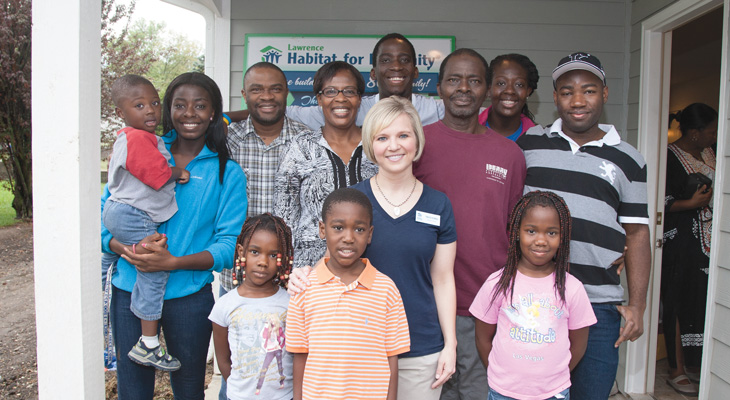Executive Director, Lawrence Habitat for Humanity
Third Quarter 2012
story by ANNE BROCKHOFF
photos by STEVEN HERTZOG
Habitat for Humanity is perhaps one of the world’s best-known non-profits. It’s built 500,000 homes in countries as diverse as Germany, Brazil and Zambia since its inception in 1976. Habitat’s attracted support from the likes of President Jimmy Carter, and, in 2011, it became the sixth-largest homebuilder in the U.S.
So, how do you make an organization that big feel so local?
“It honestly is about connecting people and connecting community members,” says Tracie Howell, executive director of Lawrence Habitat for Humanity. “I’m continually networking and finding people who have a passion for what we do.”
And she does it at a whirlwind pace. On any given day, Howell might meet with the organization’s 16-member board of directors, lunch with volunteers and attend committee meetings. There are building site visits, and she might even prepare food for a dinner like the one given in July for Bike & Build, a cross-country bicycling group that stopped in Lawrence to work on a Habitat house.
“That’s what I do every day, and it’s something different every single moment of my day,” says the 38-year-old Howell, who grew up in Lansing, Kan.
Lawrence Habitat currently builds four houses a year, and each takes about four months to complete. Volunteers do most of the building. Local contractors install plumbing, electrical and other systems, and other businesses donate materials, food and supplies.
Homeowners contribute hours of “sweat equity” on their own and others’ houses, as well as in Habitat ReStore, which sells gently used building materials and household goods.
The typical Habitat homeowner takes on a zero-percent interest, 25-year mortgage of about $65,000 to cover the cost of building materials. Lawrence Habitat holds the mortgages, which gives the organization greater flexibility to work with homeowners, Howell says.
Howell and her staff of five full-time employees, an AmeriCorps VISTA member and countless volunteers manage it all.
“It’s a huge collaborative effort,” says Howell, who holds a business management and marketing degree from Emporia State University and a masters in higher education administration from the University of Kansas.
She readily admits her enthusiasm for Habitat’s mission makes it hard to talk about anything else. Even a discussion about past jobs at the University of Dallas-Texas, Plymouth State University and the University of North Carolina-Wilmington and as director of the United Way Roger Hill Volunteer Center in Lawrence turn to how they prepared Howell for her current position.
She credits those experiences with teaching her how to manage budgets and volunteers, coordinate marketing and fundraising campaigns, network, write and manage grants and foster community relationships. Howell brought all those skills to bear when she joined Lawrence Habitat in 2011, but there was still a sharp learning curve.
“I didn’t know anything about how to build a house,” she says. “I never would have walked onto a building site, but now I do it every day in heels and a dress.”
That includes Saturdays, too, when most volunteers and families turn out to work on the houses. Howell and her three-year-old son usually stop at building sites en route to his gymnastics class.
It’s not a nine-to-five life, Howell says, but it still leaves plenty of time to volunteer with the Junior League of Kansas City and the American Heart Association’s Go Red for Women campaign.
Howell and her husband often have dinner with neighbors on Friday nights. On other evenings and Saturday mornings, she’s at the gym, punch boxing or doing Zumba. She still gets eight hours a sleep a night, and wakes each day determined to make a difference.
“I just have a passion to address that need and do what we can to help,” Howell says. “If we don’t have viable community members, we don’t have a successful community.”

